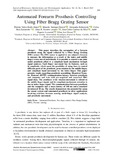Mostrar el registro sencillo del ítem
Automated forearm prosthesis controlling using fiber bragg grating sensor
| dc.creator | Valera Rialto Júnior, Péricles | es_ES |
| dc.creator | Dureck, Eduardo Henrique | es_ES |
| dc.creator | Kalinowski, Alessandra | es_ES |
| dc.creator | Ruiz Zamarreño, Carlos | es_ES |
| dc.creator | Socorro Leránoz, Abián Bentor | es_ES |
| dc.creator | Cardozo da Silva, Jean Carlos | es_ES |
| dc.creator | Lazzaretti, André Eugenio | es_ES |
| dc.creator | Dreyer, Uilian José | es_ES |
| dc.date.accessioned | 2023-05-04T15:33:35Z | |
| dc.date.available | 2023-05-04T15:33:35Z | |
| dc.date.issued | 2023 | |
| dc.identifier.citation | Rialto Júnior, P. V., Dureck, E. H., Kalinowski, A., Zamarreño, C. R., Socorro-Leranoz, A. B., Silva, J. C. C. D., Lazzaretti, A. E., & Dreyer, U. J. (2023). Automated forearm prosthesis controlling using fiber bragg grating sensor. Journal of Microwaves, Optoelectronics and Electromagnetic Applications, 22(1), 208-218. https://doi.org/10.1590/2179-10742023v22i1271724 | en |
| dc.identifier.issn | 2179-1074 | |
| dc.identifier.uri | https://hdl.handle.net/2454/45239 | |
| dc.description.abstract | This paper describes the automation of a forearm prosthesis using the signal collected by a Fiber Bragg Grating (FBG) sensor. The FBG sensor is applied to one subject's forearm to measure the deformation as a result of the index and middle fingers when moved individually. It is possible to control a one joint model prosthesis allied to a compliant hand mechanism through signal analyses. Each finger movement has its features, such as its amplitude, which opens the possibility of using those to control different parts of the prosthesis, joint rotation by the middle finger, and compliant hand movement by the index finger. This paper presents results regarding prosthesis assembling, Hypertext Transfer Protocol (HTTP) communication latency between prosthesis and computer and tests with pre-acquired and processed FBG signal data. The prosthesis wrist rotation movement is related to the middle finger signal, and its compliant mechanism actuation is due to index finger signal. The communication between prosthesis and the computer had a mean latency of 140 ms and a standard deviation of 18 ms. The results demonstrate the potential for using the sensor system and automated prosthesis in other applications involving real-time forearm sensing, multi-finger signal analysis, and prosthetic movement. | en |
| dc.description.sponsorship | The authors acknowledge CAPES (Coordination of Superior Level Staff Improvement), CNPQ (National Council for Scientific and Technological Development), FINEP (Funding Authority for Studies and Projects), Araucária Foundation, and SETI (State Secretary of Science, Technology, and Higher Education of Paraná), and Multi-User Photonics Facility - UTFPR-CT. This study was financed in part by the Coordenação de Aperfeiçoamento de Pessoal de Nível Superior - Brasil (CAPES) - Finance Code 001. | ee |
| dc.format.mimetype | application/pdf | en |
| dc.language.iso | eng | en |
| dc.publisher | Sociedade Brasileira de Microondas e Optoeletrônica e Sociedade Brasileira de Eletromagnetismo | po |
| dc.relation.ispartof | Journal of Microwaves, Optoelectronics and Electromagnetic Applications, 22(1), 2023 | en |
| dc.rights | © 2023 SBMO/SBMag. Creative Commons Attribution 4.0 International (CC BY 4.0). | en |
| dc.rights.uri | http://creativecommons.org/licenses/by/4.0/ | |
| dc.subject | Automated prosthesis | en |
| dc.subject | Two finger control | en |
| dc.subject | Fiber Bragg grating (FBG) | en |
| dc.subject | Forearm sensing | en |
| dc.title | Automated forearm prosthesis controlling using fiber bragg grating sensor | en |
| dc.type | Artículo / Artikulua | es |
| dc.type | info:eu-repo/semantics/article | en |
| dc.date.updated | 2023-05-04T15:25:20Z | |
| dc.contributor.department | Ingeniería Eléctrica, Electrónica y de Comunicación | es_ES |
| dc.contributor.department | Ingeniaritza Elektrikoa, Elektronikoa eta Telekomunikazio Ingeniaritza | eu |
| dc.rights.accessRights | Acceso abierto / Sarbide irekia | es |
| dc.rights.accessRights | info:eu-repo/semantics/openAccess | en |
| dc.identifier.doi | 10.1590/2179-10742023v22i1271724 | |
| dc.relation.publisherversion | https://doi.org/10.1590/2179-10742023v22i1271724 | |
| dc.type.version | Versión publicada / Argitaratu den bertsioa | es |
| dc.type.version | info:eu-repo/semantics/publishedVersion | en |



